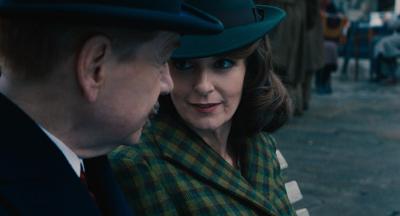
A Haunting in Venice
You could say A Haunting in Venice is a dim, dizzy do-over for director-star Kenneth Branagh.
After proving that today’s audiences will go see all-star murder mysteries with his hit 2017 adaptation of Murder on the Orient Express, Branagh followed it up with another Agatha Christie title — Death on the Nile, with Gal Gadot, Armie Hammer and Russell Brand among the cast. Plagued by production issues and a little thing known as the COVID-19 pandemic, Death went from a planned December 2019 release date to finally seeing the light of day two Februarys ago, when it performed underwhelmingly at the box office. Plus, by the time the movie came out, Hammer had been kicked outta Hollywood for sexual misconduct, Brand had become the British Alex Jones, and Gadot was still living down the embarrassment of leading a COVID-inspired celebrity sing-along of “Imagine” on social media.
Branagh lowers the star wattage considerably — along with the lights — for his latest whodunit. He and trusty screenwriter Michael Green mostly pick up bits and pieces from Christie’s 1969 novel Hallowe’en Party (critically reviled upon release) and composed their own old-school, supernatural yarn.
Branagh takes the story from England to Italy, where a cynical, retired detective Hercule Poirot is still being hit up to solve cases in Venice, circa 1947. (Riccardo Scamarcio’s policeman-turned-bodyguard usually cuts off these pests by clotheslining them or elbowing them off a bridge.) But one of them is old pal and mystery novelist Ariadne Oliver (Tina Fey), who wants him to debunk an “unholy” medium (played all too briefly by Michelle Yeoh) who’s been called on to contact the dead daughter of a grieving opera singer (Yellowstone’s Kelly Reilly). When people start getting offed, Poirot begins interrogating suspects, including a disturbed doctor (Jamie Dornan), his supportive son (Jude Hill, who played the lead in Branagh’s Oscar-winning Belfast), a distraught nanny (Camille Cottin), and the daughter’s ex-fiancé (Kyle Allen).
Branagh and Green really lay on the spooky stuff. After all, the movie mostly takes place on Halloween, in a haunted palazzo that once housed orphaned kids who died tragically. As he’s shown in the previous installments, Branagh creates images that are more impeccable than suspenseful. While Poirot quietly starts freaking out as he sees and hears things that aren’t there, this primarily nocturnal ghost story is still light on darkness.
With the inclusion of Fey’s sarcastic Oliver, it seems that Branagh paid attention to those who criticized him for taking all the fun out of Poirot. Fey adds a bit of sassy comic relief here and there as Poirot’s de facto girl Friday, aiding him in rounding up suspects and clues. Branagh and Fey do have a fun rapport, so it’s kinda unfortunate that their relationship consists of Poirot solving the mystery and Oliver making witty remarks.
As flawed as Haunting is story-wise, Branagh does go about making some well-crafted, moody shit you can watch with either your date or your dad. (I wonder if Branagh is gonna strike up some 70 mm engagements on this one like he did Murder and Death.) It almost seems like the director went through the filmographies of Stanley Kubrick and Ken Russell for ideas on how to make Gothic horror that’s just as claustrophobic for the audience as it is for the characters. (There are some fisheye-lens shots that, as always, make you feel like you’re tripping on bad edibles.)
Even though Rian Johnson has become the new master of mystery popcorn flicks with the Knives Out franchise, there is something a bit comforting — even adorable – about Branagh continually getting money so he can slap on a wild-ass mustache, talk in a Belgian accent and make/star in movies based on Agatha Christie page-turners. Since this is officially a cinematic universe, I guess we’ll be getting some Miss Marple movies next.





